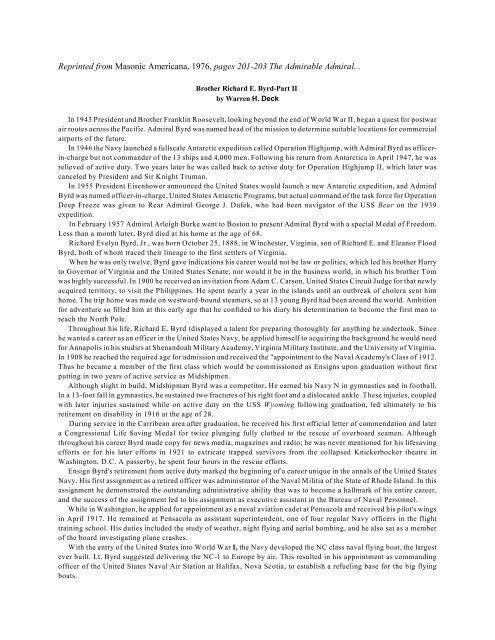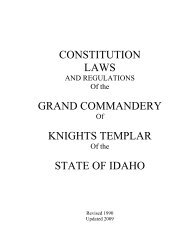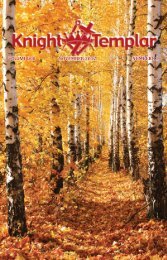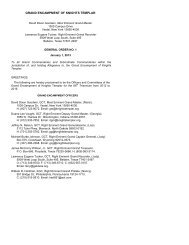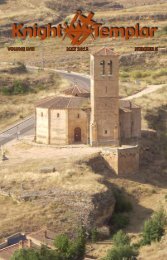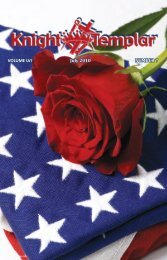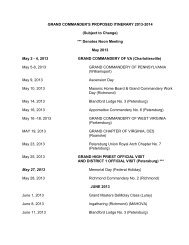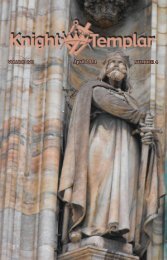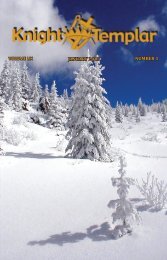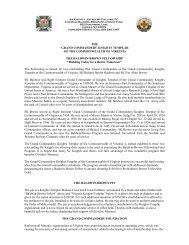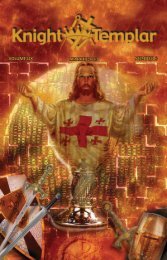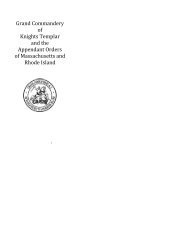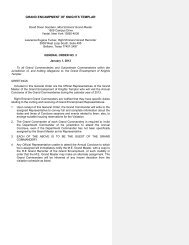Brother Richard E. Byrd - Part II
Brother Richard E. Byrd - Part II
Brother Richard E. Byrd - Part II
- No tags were found...
You also want an ePaper? Increase the reach of your titles
YUMPU automatically turns print PDFs into web optimized ePapers that Google loves.
Reprinted from Masonic Americana, 1976, pages 201-203 The Admirable Admiral...<strong>Brother</strong> <strong>Richard</strong> E. <strong>Byrd</strong>-<strong>Part</strong> <strong>II</strong>by Warren H. DeckIn 1943 President and <strong>Brother</strong> Franklin Roosevelt, looking beyond the end of World War <strong>II</strong>, began a quest for postwarair routes across the Pacific. Admiral <strong>Byrd</strong> was named head of the mission to determine suitable locations for commercialairports of the future.In 1946 the Navy launched a fullscale Antarctic expedition called Operation Highjump, with Admiral <strong>Byrd</strong> as officerin-chargebut not commander of the 13 ships and 4,000 men. Following his return from Antarctica in April 1947, he wasrelieved of active duty. Two years later he was called back to active duty for Operation Highjump <strong>II</strong>, which later wascanceled by President and Sir Knight Truman.In 1955 President Eisenhower announced the United States would launch a new Antarctic expedition, and Admiral<strong>Byrd</strong> was named officer-in-charge, United States Antarctic Programs, but actual command of the task force for OperationDeep Freeze was given to Rear Admiral George J. Dufek, who had been navigator of the USS Bear on the 1939expedition.In February 1957 Admiral Arleigh Burke went to Boston to present Admiral <strong>Byrd</strong> with a special Medal of Freedom.Less than a month later, <strong>Byrd</strong> died at his home at the age of 68.<strong>Richard</strong> Evelyn <strong>Byrd</strong>, Jr., was born October 25, 1888, in Winchester, Virginia, son of <strong>Richard</strong> E. and Eleanor Flood<strong>Byrd</strong>, both of whom traced their lineage to the first settlers of Virginia.When he was only twelve, <strong>Byrd</strong> gave indications his career would not be law or politics, which led his brother Harryto Governor of Virginia and the United States Senate; nor would it be in the business world, in which his brother Tomwas highly successful. In 1900 he received an invitation from Adam C. Carson, United States Circuit Judge for that newlyacquired territory, to visit the Philippines. He spent nearly a year in the islands until an outbreak of cholera sent himhome. The trip home was made on westward-bound steamers, so at 13 young <strong>Byrd</strong> had been around the world. Ambitionfor adventure so filled him at this early age that he confided to his diary his determination to become the first man toreach the North Pole.Throughout his life, <strong>Richard</strong> E. <strong>Byrd</strong> (displayed a talent for preparing thoroughly for anything he undertook. Sincehe wanted a career as an officer in the United States Navy, he applied himself to acquiring the background he would needfor Annapolis in his studies at Shenandoah Military Academy, Virginia Military Institute, and the University of Virginia.In 1908 he reached the required age for admission and received the "appointment to the Naval Academy's Class of 1912.Thus he became a member of the first class which would be commissioned as Ensigns upon graduation without firstputting in two years of active service as Midshipmen.Although slight in build, Midshipman <strong>Byrd</strong> was a competitor. He earned his Navy N in gymnastics and in football.In a 13-foot fall in gymnastics, he sustained two fractures of his right foot and a dislocated ankle. These injuries, coupledwith later injuries sustained while on active duty on the USS Wyoming following graduation, led ultimately to hisretirement on disability in 1916 at the age of 28.During service in the Carribean area after graduation, he received his first official letter of commendation and latera Congressional Life Saving Medal for twice plunging fully clothed to the rescue of overboard seamen. Althoughthroughout his career <strong>Byrd</strong> made copy for news media, magazines and radio; he was never mentioned for his lifesavingefforts or for his later efforts in 1921 to extricate trapped survivors from the collapsed Knickerbocker theatre inWashington, D.C. A passerby, he spent four hours in the rescue efforts.Ensign <strong>Byrd</strong>'s retirement from active duty marked the beginning of a career unique in the annals of the United StatesNavy. His first assignment as a retired officer was administrator of the Naval Militia of the State of Rhode Island. In thisassignment he demonstrated the outstanding administrative ability that was to become a hallmark of his entire career,and the success of the assignment led to his assignment as executive assistant in the Bureau of Naval Personnel.While in Washington, he applied for appointment as a naval aviation cadet at Pensacola and received his pilot's wingsin April 1917. He remained at Pensacola as assistant superintendent, one of four regular Navy officers in the flighttraining school. His duties included the study of weather, night flying and aerial bombing, and he also sat as a memberof the board investigating plane crashes.With the entry of the United States into World War I, the Navy developed the NC class naval flying boat, the largestever built. Lt. <strong>Byrd</strong> suggested delivering the NC-1 to Europe by air. This resulted in his appointment as commandingofficer of the United States Naval Air Station at Halifax, Nova Scotia, to establish a refueling base for the big flyingboats.
It was during this period that Lt. <strong>Byrd</strong> and Lt. WaIter Hinton developed a sextant for aerial use applying thecarpenter's level principle of a bubble glass to replace the sea horizon used by surface navigators.When the first transatlantic crossing by air was finally made by the NC4 under Lt. Commander Read, the official NavyDepartment announcement acknowledged the contributions of Lt. Commander R. E. <strong>Byrd</strong>, Jr., to celestial navigation:the <strong>Byrd</strong> sextant, drift and speed indicator, course and distance indicator, and zenithal projection of the Atlanticeliminating lengthy mathematical calculations of the past. Although his ambition to be a member of the first group to flyacross the Atlantic was thwarted, his contributions to the success of the expedition and to the later development ofcommercial aviation 'were many and great.In the period immediately following World War I, while General Billy Mitchell crusaded for a separate air force anddramatized air power by sinking ships, <strong>Byrd</strong> played a decisive role in the Navy's efforts to develop the Naval Bureau ofAeronautics.<strong>Byrd</strong>'s position was unique. While older officers were sea dogs opposed to aviation, <strong>Byrd</strong> was regular Navy fromAnnapolis and a trained pilot. As a retired officer, he had no career to thwart and could not be cashiered for speakingout. The most severe penalty which could be invoked would be to return him to inactive duty. <strong>Byrd</strong> wrote a sample billfor the creation of a Bureau of Aeronautics in the Navy Department, testified before Congressional Committees in itsbehalf, and successfully lobbied in Congress for its passage.It was at <strong>Byrd</strong>'s suggestion at the end of World War I that a Naval Reserve program was established to afford Navypilots an opportunity to keep up their flying skills after their return to civilian-life. In the establishment of the first reservecenter in Massachusetts, <strong>Byrd</strong> not only recruited the former pilots to volunteer for the reserve training but even succeededin getting them to give their time to building and renovating the facilities.In addition to being an able administrator, scientist and explorer; <strong>Byrd</strong> was the author of four books: Skyward, LittleAmerica, Discovery and Alone.Raised in Federal Lodge No.1, Washington, D.C., in 1921; he later affiliated with Kane Lodge No. 454, New YorkCity. He was also a member of National Sojourners Chapter No.3 at Washington. <strong>Byrd</strong> dropped Masonic flags over bothpoles during his flights. Sixty of the 82 members of his Antarctic expedition of 1933-1935 were Freemasons. Theyestablished First Antarctic Lodge No. 777 of New Zealand in 1935.


